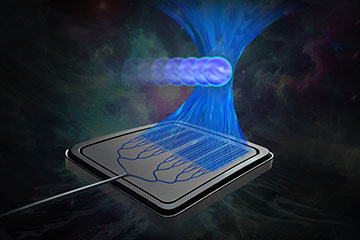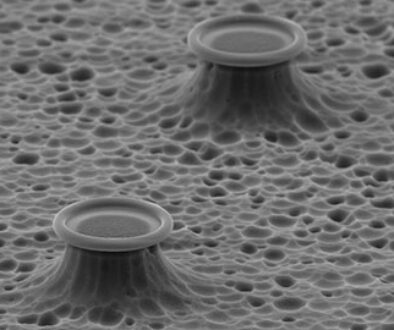
Artist’s conception of a chip-based “tractor beam,” which uses an intensely focused beam of light to capture and manipulate biological particles without damaging the cells. This type of tractor beam could help biologists study the mechanisms of diseases. [Image: Sampson Wilcox, MIT Research Laboratory of Electronics]
Researchers at a US university have developed an integrated “tractor beam” that performs the work of optical tweezers on a photonic chip, without the need for bulky benchtop setups (Nat. Commun., doi:10.1038/s41467-024-52273-x). The optical phased array (OPA) at the heart of the device allows the manipulation of particles more than 100 times farther from the chip surface than in previous experiments with miniaturized tweezers. This capability could enable scientists to move cells without removing them from a sterile environment or even while the cells remain in vivo.
Bulky equipment, short standoff distances
For nearly half a century, optical trapping of particles has given scientists the opportunity to manipulate individual protein strands and other tiny objects without actually touching them. Standard optical tweezers, however, have required bulky, specialized lasers and other equipment.
Previous attempts to integrate optical trapping into photonic-chip systems used evanescent fields from resonators or waveguides, but these chips had to be only a few microns from the traps in order to work. This restriction interfered with sterile glass enclosures or cell-culture wells that were at least 150-μm thick.
An integrated OPA could provide light on the chip scale. But until Jelena Notaros and her colleagues at the Massachusetts Institute of Technology (MIT), developed such an integrated phased array with a focused beam profile, OPAs could not focus tightly enough to perform optical trapping.
Demonstrating the potential
Until Jelena Notaros and her colleagues … developed such an integrated phased array with a focused beam profile, OPAs could not focus tightly enough to perform optical trapping.
In the current work, Notaros and her team designed an OPA with a hyperbolic phase distribution that creates a tightly focused radiation pattern some 5 mm above the array, which was patterned on a silicon-on-insulator wafer. The OPA operates at a center wavelength of 1500 nm, but to steer a microparticle or cell, the researchers varied the input wavelength to alter the effective period of the array’s tiny antennas, changing their angle of radiation emission.
After calibrating the trapping force of the OPA chip, the team practiced moving polystyrene microspheres with the optical tweezers. Finally, Notaros and her colleagues demonstrated selecting and stretching individual mouse cells and observing how the cells recovered their shapes with the laser turned off. Stretching the mouse cells took a wavelength change of 0.6 nm.
“This work opens up new possibilities for chip-based optical tweezers by enabling trapping and tweezing of cells at much larger distances than previously demonstrated,” Notaros said in a press statement. “It’s exciting to think about the different applications that could be enabled by this technology.”


